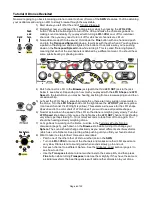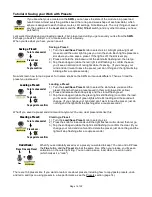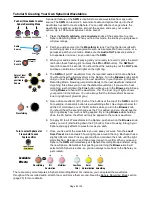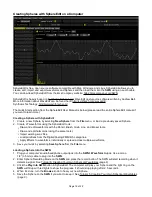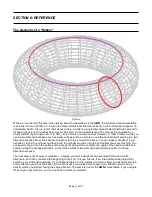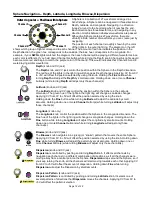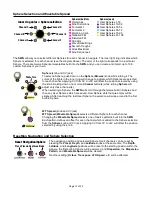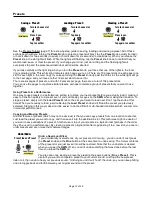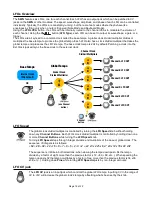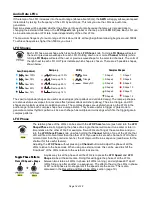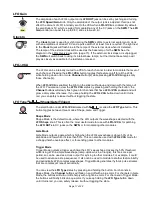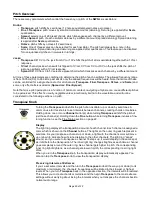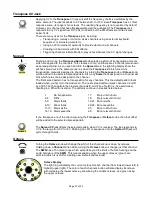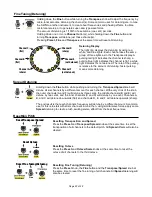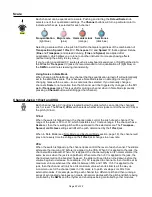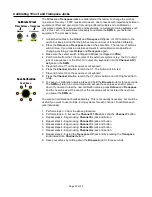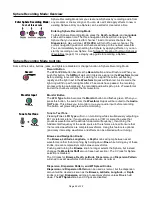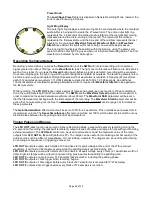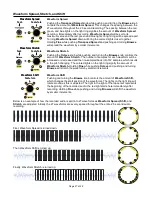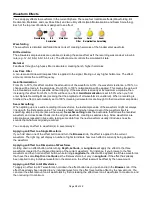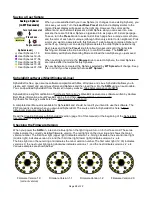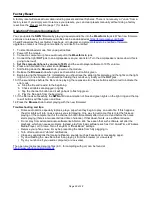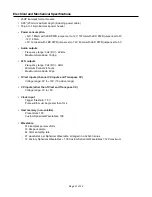
Pitch Overview
There are many parameters which control the frequency, or pitch, of the
SWN
’s six oscillators:
Knobs:
•
Transpose
: pitch shifts by semitones (12 notes equal tempered notes per octave).
•
Fine + Transpose
: pitch moves by small microtonal amounts (detuning). Detuning is applied after
Scale
quantization.
•
Spread
: selects one of 26 preset chords, which transposes each channel by a different amount.
•
Fine + Spread
: pitch of each oscillator detunes by a different amount (spread detuning). Spread detuning
is applied after
Scale
quantization.
•
Octave
:
pitch shifts by octaves (12 semitones).
•
Scale
: One of three scales can be selected for each oscillator. The pitch will always be a note in the
selected scale. Spread detuning and detuning are applied after quantization. This feature can be disabled
for non-quantized pitches or non-western tunings.
Jacks:
•
Transpose CV
: CV on the jack from 0V to +10V shifts the pitch of all six oscillators together with a 1V/oct
response.
•
1V/oct
channel
jacks: when switch is flipped to 1V/oct, CV from 0V to +10V on the jack shifts the pitch of
just one oscillator with a 1V/oct response.
•
Spread CV
: CV from 0 to 5V selects a preset chord which transposes each channel by a different amount.
All nine of these parameters are combined to determine the pitch of each oscillator. The allowed frequency range
is from 16.35Hz (C0) to 96.3kHz; past 22kHz only the aliased frequencies will be heard. Note that some of these
can be controlled for a single channel or for all channels (
Transpose
,
Fine+Transpose
,
Octave
, and
Scale
) and
some only effect all six oscillators (
Spread
and
Fine+Spread
).
Note that since pitch perception is a function of harmonic content, navigating a Sphere
can cause different pitches
to be perceived. This effect is usually negligible unless intentionally built into the wavetable, and will not be
considered in the following sections on pitch.
Transpose Knob
Turning the
Transpose
knob shifts the pitch of an oscillator up or down by semitones. A
common use for this knob is
to set intervals between channels, creating chords or melodies.
Holding down one or more
Channel
button(s)
while turning
Transpose
will shift the pitch of
just those channel(s). Holding down the
Fine
button
while turning
Transpose
invokes a fine-
tuning function, see the Fine Tuning
section on page 22.
Display
The light ring displays the transposition amount of each channel. Each channel is assigned a
color, which is shown on the
Channel
buttons. The lights on the outer ring each represent a
semitone. As you transpose a channel up or down, a light with the channel’s color will move
up or down to indicate how it’s tuned relative to the other channels. The light ring “wraps”
around, so if you were to transpose a channel 18 steps up, it would display in the same spot
as it did before the transposition. The inner light ring changes brightness each time a channel
goes completely around the outer ring. As a channel gets higher in pitch, the corresponding
inner ring light brightens; as a channel gets lower in pitch, the corresponding inner ring light
dims.
When you turn the
Transpose
knob, the transposition display automatically appears. You
also can tap the
Transpose
knob to view the transposition display.
Preserving Intervals at Extremes
If you’ve set some intervals and then turn the
Transpose
knob
all the way up or down (to its
maximum or minimum), the channels’ frequencies will be limited to their lowest or highest
levels. When you turn
Transpose
back in the opposite direction, the intervals will be restored.
This allows you to create chords or melodies and then spin
Transpose
to the most extreme
settings without worrying about losing the intervals when you transpose the channels back to
normal audio range.
Page of
20
32
Spread

